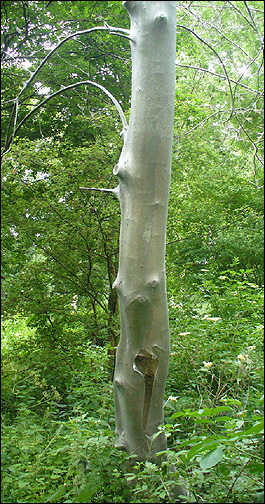

At the end of May, I encountered a veiled tree in the park near my work. The veil around the tree stem was the combined work of thousands of caterpillars of a species of ermine moth that congregated together to make a communal silk nest to protect themselves from predators. They can strip whole trees bare of foliage. but the trees normally regenerate. (For more information about ermine moths, see http://en.wikipedia.org/wiki/Ermine_moth)
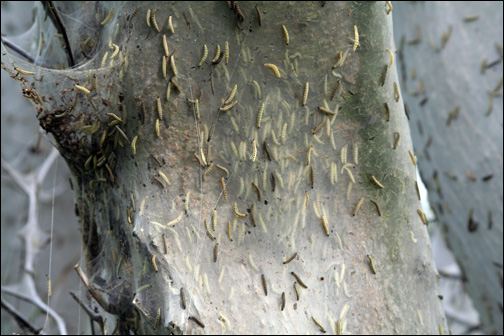
Ermine moth caterpillars in a communal silk nest.
Photo attributed to N. P. Holmes (from Wikipedia)

Adult ermine moth
Photo attributed to Entomart (from Wikipedia)
Most of the species here in Holland looks like the moth in the photo above. The species can best be identified by the host tree or plant species that the caterpillars feed on. In some cases, even objects near the trees are encapsulated by the caterpillars.
(A bicycle covered in caterpillar silk, see http://walterreeves.com/insects_animals/article.phtml?cat=21&id=936)
Out of curiosity, I stripped a piece of the silk from the tree bark. It felt smooth like satin and was quite strong. After removing three encapsulated caterpillars, I had a 5 x 30 cm strip of silk. I turned it into a small piece of cordage by rolling the strip on my thigh. The end result was quite similar to dental floss in thickness and strength. As a test, I put one half of the strand in water overnight and compared it in the morning with the other half that was left dry. There was no difference in strength or elasticity of the thread.
The next day I went back to take some pictures and do some more testing.
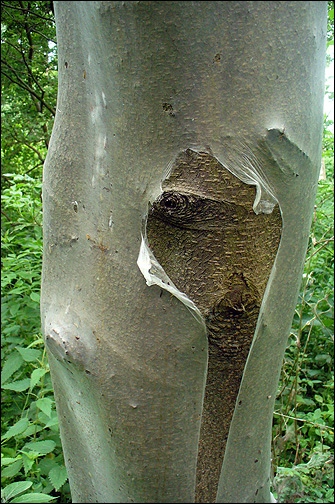
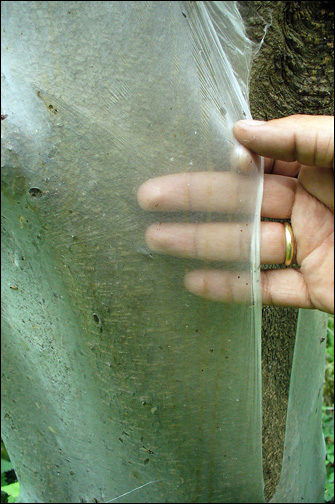
Here´s the tree again, with my hand poking in the hole that was made by my initial test the day before. In this state it sheds most water, but it can get wet. The silk is spun quite tightly around the bark. but does not make real contact. There´s some space in between the silk and the bark.

Small strip of silk torn off.
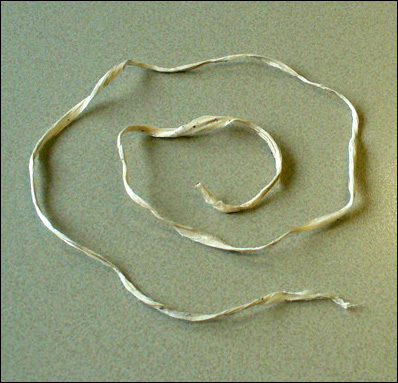
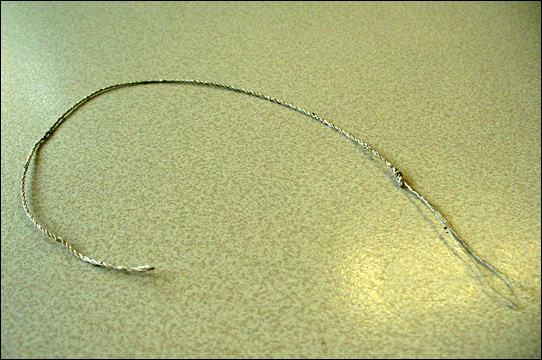
Same strip turned onto itself and made into a short piece of cordage.
A full 1.5 liter cola-bottle was no match and was lifted with ease. The cordage was slightly elastic and felt very strong. I reckon it can be made into snares. It might even work as a fishing line.
Other Uses:

1) Instant band-aid (although the caterpillar silk might not be sterile). It will probably work as a styptic by enlarging the blood surface area.
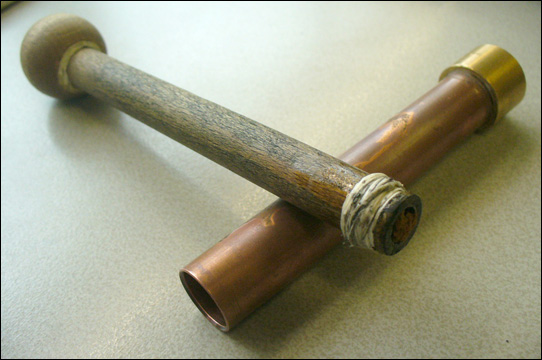
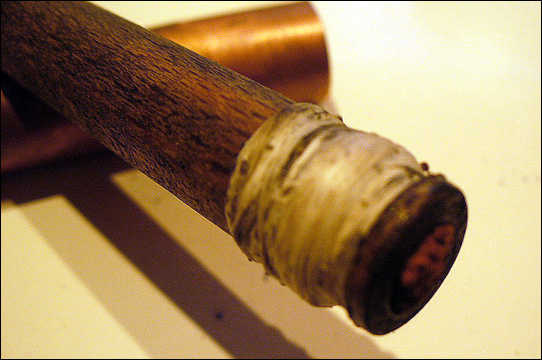
2) Airtight seal for a fire piston instead of using a rubber O-ring. It looks and works a bit like the teflon tape plumbers use. It gave me a chaga coal in two tries.
3) The silk works well, placed over a straw, as a filter for draining sand/silt particles out of water. In theory, a sheet of ermine moth silk could even be used to filter coffee, assuming there are no funny chemicals in ermine moth silk.
4) As ermine moth silk is see-through and breathable, a small sheet of it could possibly be used as a piece of no-see-um netting to keep insects at bay.
5) The silk thread also works great as dental floss.
I tried to turn the ermine moth silk into felt, but this didn’t work. Two sheets of the stuff merely slide over each other and do not cling.
Conclusion
Fresh ermine moth caterpillar silk is a surprisingly strong and versatile material and can be used for making strong cordage (not affected by water) amongst other things. With some care, long strips can be pulled off the tree, which needs less spicing when turning it into cordage. Collecting ermine moth silk strips or sheets by rolling them onto a stick works best for me. Unrolling the silk is easy, as it doesn’t stick. If my clothes needed some on-the-trail-stitching, I´d use this stuff.
Epilogue
At the start of July, one and a half month after my first encounter, the silk sheets around the tree in the park were dotted with caterpillar droppings, empty cocoons and little escape holes. The caterpillars had all left their protective silk tent as beautiful speckled adult moths and were now swarming around the tree. In early September, the remaining silk had degraded severely. It was thinner, more fragile, less elastic and had lost it's silken touch. A piece of cordage now made out of it proved easy to break. In contrast, my little piece of cordage from the end of May had not lost any of it’s strength after more than four months. Although this cordage was kept indoors during those months, I would expect that a piece of cordage made out of fresh ermine moth silk, that was kept outdoors, would degrade a lot slower than a silken sheet on the tree because it exposes less surface to possible degradation (for instance by ultraviolet radiation or oxidation). Furthermore, turning a strip of ermine moth silk into cordage introduces fats and oils from the hand palms into the material, thus protecting it even more from moistness.
By October, and after a few windy and rainy days, the last remaining sheets of ermine moth silk that clung onto the tree have gone. In about six or seven months, there will be a new generation of caterpillars turning a few chosen trees into a veiled work of art.
Related video link:
Fishing with spider web in the South Pacific
E-mail your comments to "Tom Lourens" in the Netherlands at t.lourens@sanquin.nl.
We hope the information on the PrimitiveWays website is both instructional and enjoyable. Understand that no warranty or guarantee is included. We expect adults to act responsibly and children to be supervised by a responsible adult. If you use the information on this site to create your own projects or if you try techniques described on PrimitiveWays, behave in accordance with applicable laws, and think about the sustainability of natural resources. Using tools or techniques described on PrimitiveWays can be dangerous with exposure to heavy, sharp or pointed objects, fire, stone tools and hazards present in outdoor settings. Without proper care and caution, or if done incorrectly, there is a risk of property damage, personal injury or even death. So, be advised: Anyone using any information provided on the PrimitiveWays website assumes responsibility for using proper care and caution to protect property, the life, health and safety of himself or herself and all others. He or she expressly assumes all risk of harm or damage to all persons or property proximately caused by the use of this information.
© PrimitiveWays 2013